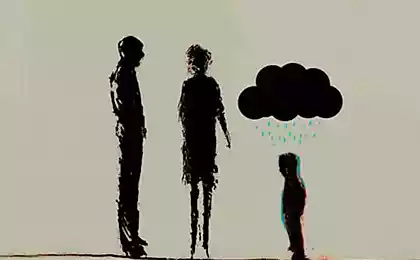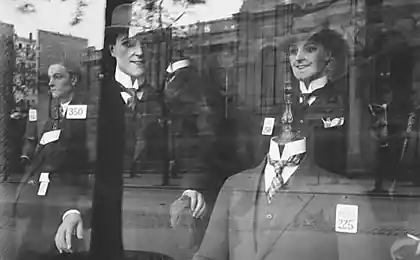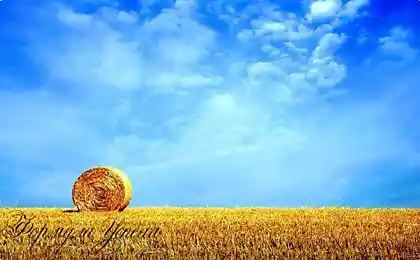354
Clip thinking: the phenomenon of modernity
Hear the word. "clip"People, most often, combine it with music, video - and this is not accidental, since in English "clip" - "cut off; clipping (from the newspaper); excerpt (from the film), cutting."
The word “clip” refers the reader to the principles of building music videos, more precisely to those varieties where the video series is loosely related images.
On the basis of the construction of a music video, and clipboardThat is, a person perceives the world not holistically, but as a series of almost unrelated parts, facts, events. The owner of clip thinking is difficult, and sometimes not able to analyze any situation, because her image does not linger in thoughts for a long time, he almost immediately disappears, and his place immediately takes a new (endless switching of TV channels, watching news, advertising, trailer for the film, reading blogs...).

Currently, the media is actively exaggerating the word “clip” in the context of thinking. This phenomenon did not happen overnight, the term “clip thinking” in the philosophical and psychological literature appeared in the late 90s of the twentieth century and denoted the feature of a person to perceive the world through a short, bright message embodied in the form of either a video clip (hence the name), or telenews.
Initially, it was the media, not the World Wide Web, that developed a universal format for presenting information - the so-called sequence of relevant clips. The clip, in this case, is a short set of theses, submitted without defining the context, since due to its relevance, the context for the clip is objective reality. Thus, a person is able to freely perceive and interpret a clip due to the fact that he is immersed in this very reality.
In fact, not everything is as beautiful as it looks at first glance, because, due to the fragmentation of information and the separation of related events over time, the brain simply cannot be aware of and comprehend the connections between events. The format of media causes the brain to make the fundamental error of comprehension – to consider events as related if they have a temporal proximity rather than a factual one. So it's not surprising that The emergence of clip thinking is a response to an increased amount of information.
Confirmation of this can be found in the theory of stages in the development of civilization of M. McLuhan: "... society, being at the present stage of development, is transformed into an "electronic society" or a "global village" and sets, through electronic means of communication, a multidimensional perception of the world. The development of electronic means of communication returns human thinking to the pre-text era, and the linear sequence of signs ceases to be the basis of culture.”
Abroad, the term “clip thinking” is replaced by a broader one – “clip culture”, and is understood in the works of the American futurologist E. Toffler as a fundamentally new phenomenon, considered as a component of the general information culture of the future, based on the endless flickering of information segments and a corresponding mindset comfortable for people. In his book The Third Wave, Toffler describes clip culture as follows:
On a personal level, we are besieged and blinded by contradictory and unrelated fragments of the image series, which knock the ground out from under the feet of our old ideas, shell us with torn, meaningless “clips”, instant shots.

Clip culture forms such unique forms of perception as "zapping" (English zapping, channel zapping - the practice of switching TV channels) when by non-stop switching of television channels, a new image is created, consisting of fragments of information and fragments of impressions.. This image does not require the connection of imagination, reflection, comprehension, all the time there is a “reset”, “update” of information, when everything originally seen without a temporary break loses its meaning, becomes obsolete.
In Russian science, the first to use the term “clip thinking” philosopher-archaeoavant-garde F.I. Girenok, believing that conceptual thinking has ceased to play an important role in the modern world:
You asked what is happening in philosophy today, and what is happening is replacing linear, binary thinking with nonlinear thinking. European culture is based on evidence. Russian culture, since its roots are Byzantine, is on the display system. And we have cultivated in ourselves, perhaps after I. Damascene, an understanding of pictures. We formed not conceptual thinking, but, as I call it, clip thinking, ...responding only to a blow.
In 2010. Culturologist KG Frumkin identifies five prerequisites that gave rise to the phenomenon of “clip thinking”:
(1) speeding up life and directly related to it, the increase in the volume of information flow, which generates problems of selection and reduction of information, allocation of the main and filtering of excess;
(2) the need for more relevant information and the speed of its receipt;
(3) increasing diversity incoming information;
(4) an increase in the number of cases, What one person does at the same time;
(5) increased dialogue at different levels of the social system.
In general, the epithet "clip thinking" during its existence acquires a pronounced negative connotation, most often they are "rewarded" by teenagers and young people, it is believed that this type of thinking is catastrophic, because they read in snatches, listen to music in a car, through the phone, i.e. receive information with pulses, not focusing on ideas, but only on individual flashes and images.
But is this so bad and is it really only teenagers and young people who are susceptible to clip thinking?

Consider the positive (+) and negative (-) sides of clip thinking:
- Yes, When clip thinking, the surrounding world turns into a mosaic of disparate, little-related facts, parts, fragments of information. A person gets used to the fact that they are constantly, as in a kaleidoscope, changing each other and constantly demanding new ones (the need to listen to new music, chat in a chat, constantly “wander” on the network, edit photos, excerpts from action films, play online games with new participants...);
+ but, There is also the flip side of the coin: clip thinking can be used as a protective reaction of the body to information overload. If you take into account all the information that a person sees and hears in a day, plus the “world dump”. The Internet, then it is not surprising that its thinking is changing, adapting, adapting to the new world.
- Yes, In adolescents and students, “cliposity” manifests itself more clearly and this is due, firstly, to the fact that they are “in sight” of teachers who require them to read the primary sources, to take notes, and when they do not, the search for interactive methods of teaching and influence begins; secondly, with the global informatization of society and the incredibly accelerated pace of information exchange over the past decade, which instills in the adolescent confidence in a quick simple solution to a difficult task for him: why go to the library to take, and then read War and Peace, when it is enough to open Google, find, download from the network and watch the novel by Robert Bondarchuel.
+ clip thinking This is a vector in the development of human relations with information, which arose not yesterday and will disappear not tomorrow.
- Yes, clip thinking involves simplification, i.e. “takes” the depth of assimilation of the material (using the word “depth” involuntarily recalls the story of P. Zuskind “Traction to depth” and what happened to this “thrust”!);
+ clip thinking gives dynamism to cognitive activity: we often find ourselves in a situation where we remember something, but are not completely sure of the accuracy of information reproduction;
- Yes, the ability to analyze and build long logical chains is lost, the consumption of information is equated with the absorption of fast food;
+but The great classic L.N. Tolstoy said: “Short thoughts are so good that they make the serious reader think himself.”
The list goes on, one thing is clear.clip thinking has not only disadvantages - it is simply the development of some cognitive skills at the expense of others.. It’s a phenomenon that Larry Rosen believes is inherent in Generation I, raised in the era of the computer and communications boom, their increased ability to multitask. Children of the Internet generation can simultaneously listen to music, chat, surf the web, edit photos, while doing lessons. But of course, The price for multitasking is distraction, hyperactivity, attention deficit and preference of visual symbols to logic and deepening in the text..
Rada Granovskaya: People with clip thinking elite will not become
On a clip consciousness needle
There is no clear definition of clip thinking, but From all the above it follows: “clip thinking” is the process of reflecting a variety of different properties of objects, without taking into account the connections between them, characterized by fragmentation of the information flow, illogicality, complete heterogeneity of incoming information, high speed switching between parts, fragments of information, lack of a holistic picture of perception of the surrounding world. published
Author: T.V. Semenovskikh
P.S. And remember, just by changing your consciousness – together we change the world!
Source: jarki.ru/wpress/2013/02/18/3208/
The word “clip” refers the reader to the principles of building music videos, more precisely to those varieties where the video series is loosely related images.
On the basis of the construction of a music video, and clipboardThat is, a person perceives the world not holistically, but as a series of almost unrelated parts, facts, events. The owner of clip thinking is difficult, and sometimes not able to analyze any situation, because her image does not linger in thoughts for a long time, he almost immediately disappears, and his place immediately takes a new (endless switching of TV channels, watching news, advertising, trailer for the film, reading blogs...).

Currently, the media is actively exaggerating the word “clip” in the context of thinking. This phenomenon did not happen overnight, the term “clip thinking” in the philosophical and psychological literature appeared in the late 90s of the twentieth century and denoted the feature of a person to perceive the world through a short, bright message embodied in the form of either a video clip (hence the name), or telenews.
Initially, it was the media, not the World Wide Web, that developed a universal format for presenting information - the so-called sequence of relevant clips. The clip, in this case, is a short set of theses, submitted without defining the context, since due to its relevance, the context for the clip is objective reality. Thus, a person is able to freely perceive and interpret a clip due to the fact that he is immersed in this very reality.
In fact, not everything is as beautiful as it looks at first glance, because, due to the fragmentation of information and the separation of related events over time, the brain simply cannot be aware of and comprehend the connections between events. The format of media causes the brain to make the fundamental error of comprehension – to consider events as related if they have a temporal proximity rather than a factual one. So it's not surprising that The emergence of clip thinking is a response to an increased amount of information.
Confirmation of this can be found in the theory of stages in the development of civilization of M. McLuhan: "... society, being at the present stage of development, is transformed into an "electronic society" or a "global village" and sets, through electronic means of communication, a multidimensional perception of the world. The development of electronic means of communication returns human thinking to the pre-text era, and the linear sequence of signs ceases to be the basis of culture.”
Abroad, the term “clip thinking” is replaced by a broader one – “clip culture”, and is understood in the works of the American futurologist E. Toffler as a fundamentally new phenomenon, considered as a component of the general information culture of the future, based on the endless flickering of information segments and a corresponding mindset comfortable for people. In his book The Third Wave, Toffler describes clip culture as follows:
On a personal level, we are besieged and blinded by contradictory and unrelated fragments of the image series, which knock the ground out from under the feet of our old ideas, shell us with torn, meaningless “clips”, instant shots.

Clip culture forms such unique forms of perception as "zapping" (English zapping, channel zapping - the practice of switching TV channels) when by non-stop switching of television channels, a new image is created, consisting of fragments of information and fragments of impressions.. This image does not require the connection of imagination, reflection, comprehension, all the time there is a “reset”, “update” of information, when everything originally seen without a temporary break loses its meaning, becomes obsolete.
In Russian science, the first to use the term “clip thinking” philosopher-archaeoavant-garde F.I. Girenok, believing that conceptual thinking has ceased to play an important role in the modern world:
You asked what is happening in philosophy today, and what is happening is replacing linear, binary thinking with nonlinear thinking. European culture is based on evidence. Russian culture, since its roots are Byzantine, is on the display system. And we have cultivated in ourselves, perhaps after I. Damascene, an understanding of pictures. We formed not conceptual thinking, but, as I call it, clip thinking, ...responding only to a blow.
In 2010. Culturologist KG Frumkin identifies five prerequisites that gave rise to the phenomenon of “clip thinking”:
(1) speeding up life and directly related to it, the increase in the volume of information flow, which generates problems of selection and reduction of information, allocation of the main and filtering of excess;
(2) the need for more relevant information and the speed of its receipt;
(3) increasing diversity incoming information;
(4) an increase in the number of cases, What one person does at the same time;
(5) increased dialogue at different levels of the social system.
In general, the epithet "clip thinking" during its existence acquires a pronounced negative connotation, most often they are "rewarded" by teenagers and young people, it is believed that this type of thinking is catastrophic, because they read in snatches, listen to music in a car, through the phone, i.e. receive information with pulses, not focusing on ideas, but only on individual flashes and images.
But is this so bad and is it really only teenagers and young people who are susceptible to clip thinking?

Consider the positive (+) and negative (-) sides of clip thinking:
- Yes, When clip thinking, the surrounding world turns into a mosaic of disparate, little-related facts, parts, fragments of information. A person gets used to the fact that they are constantly, as in a kaleidoscope, changing each other and constantly demanding new ones (the need to listen to new music, chat in a chat, constantly “wander” on the network, edit photos, excerpts from action films, play online games with new participants...);
+ but, There is also the flip side of the coin: clip thinking can be used as a protective reaction of the body to information overload. If you take into account all the information that a person sees and hears in a day, plus the “world dump”. The Internet, then it is not surprising that its thinking is changing, adapting, adapting to the new world.
- Yes, In adolescents and students, “cliposity” manifests itself more clearly and this is due, firstly, to the fact that they are “in sight” of teachers who require them to read the primary sources, to take notes, and when they do not, the search for interactive methods of teaching and influence begins; secondly, with the global informatization of society and the incredibly accelerated pace of information exchange over the past decade, which instills in the adolescent confidence in a quick simple solution to a difficult task for him: why go to the library to take, and then read War and Peace, when it is enough to open Google, find, download from the network and watch the novel by Robert Bondarchuel.
+ clip thinking This is a vector in the development of human relations with information, which arose not yesterday and will disappear not tomorrow.
- Yes, clip thinking involves simplification, i.e. “takes” the depth of assimilation of the material (using the word “depth” involuntarily recalls the story of P. Zuskind “Traction to depth” and what happened to this “thrust”!);
+ clip thinking gives dynamism to cognitive activity: we often find ourselves in a situation where we remember something, but are not completely sure of the accuracy of information reproduction;
- Yes, the ability to analyze and build long logical chains is lost, the consumption of information is equated with the absorption of fast food;
+but The great classic L.N. Tolstoy said: “Short thoughts are so good that they make the serious reader think himself.”
The list goes on, one thing is clear.clip thinking has not only disadvantages - it is simply the development of some cognitive skills at the expense of others.. It’s a phenomenon that Larry Rosen believes is inherent in Generation I, raised in the era of the computer and communications boom, their increased ability to multitask. Children of the Internet generation can simultaneously listen to music, chat, surf the web, edit photos, while doing lessons. But of course, The price for multitasking is distraction, hyperactivity, attention deficit and preference of visual symbols to logic and deepening in the text..
Rada Granovskaya: People with clip thinking elite will not become
On a clip consciousness needle
There is no clear definition of clip thinking, but From all the above it follows: “clip thinking” is the process of reflecting a variety of different properties of objects, without taking into account the connections between them, characterized by fragmentation of the information flow, illogicality, complete heterogeneity of incoming information, high speed switching between parts, fragments of information, lack of a holistic picture of perception of the surrounding world. published
Author: T.V. Semenovskikh
P.S. And remember, just by changing your consciousness – together we change the world!
Source: jarki.ru/wpress/2013/02/18/3208/
I. D. — electric hatchback with the autopilot from Volkswagen
How to remove fat from hands: effective exercises for everyone who is tired of flabby skin























